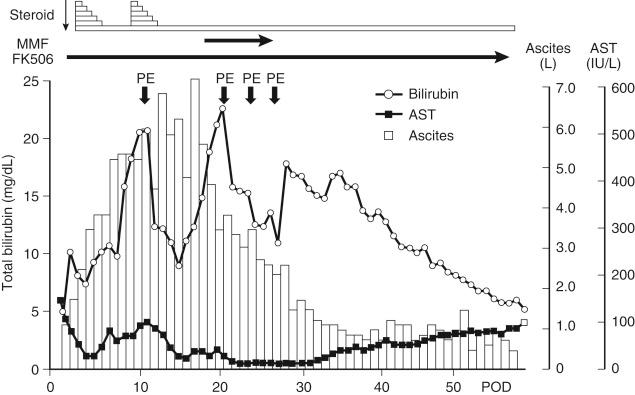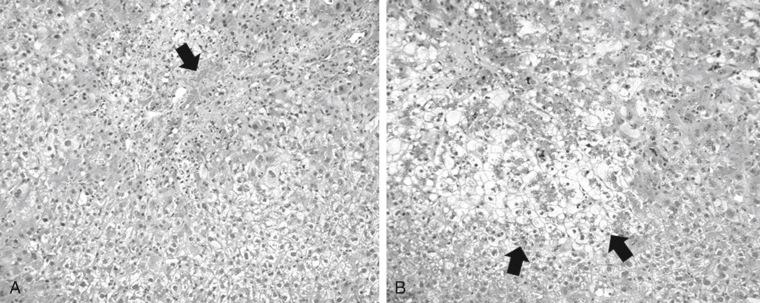Physical Address
304 North Cardinal St.
Dorchester Center, MA 02124
Split-liver transplantation and living donor liver transplantation (LDLT) in adult patients are now recognized as established treatments for end-stage liver disease. During the early days of adult LDLT, left lobe (LL) LDLT was the only option, although LL grafts constitute only 30% to 50% of the whole-liver volume ( Fig. 55-1 ). Subsequently the effect of a relatively “small” partial graft (as compared with whole-liver graft) on recipient outcome has become recognized as the most important problem to overcome. Therefore larger grafts such as right lobe (RL) grafts with or without the middle hepatic vein have been exploited, and their use is now prevalent worldwide. As such, LL LDLT has been largely abandoned in the adult population. However, many RL living donor deaths have occurred, and the legitimate continuation of this modality is now questioned. In this context a return to the original procedure (LL LDLT) has been reevaluated and has received much recent attention. Nonetheless, an accurate understanding of the small-for-size graft (SFSG) problem is important for the continued use, and improvement of the results, of LDLT. In this chapter we outline the current clinical and experimental picture of small-for-size syndrome (SFSS) based on our current experience of SFSS after LDLT.
SFSS refers to the clinical syndrome caused by a partial liver graft that is too small to sustain metabolic demand in the recipient. However, SFSS is often difficult to differentiate from other complications such as acute rejection, outflow block, and sepsis.
The concept of SFSG was first published in 1987. Emond et al first described the clinical symptoms attributable to SFSG after LDLT in their landmark paper in 1996. Subsequently the term SFSS came into use in the late 1990s when cadaveric split and LDLT in adults using partial grafts became a popular procedure. Ben-Haim et al first used the term SFSS in their preliminary report on adult LDLT outcomes. With accumulated experience of adult LDLT, SFSS is widely recognized as a distinct entity in the field of liver transplantation, especially in adult LDLT. However, there is no consensus on the definition of SFSS, and an accurate picture (incidence, prognosis, risk factors, etc.) of SFSS remains largely undetermined. Therefore it is of paramount importance to define SFSS by objective values to discuss the issue prospectively in the same arena.
Only two publications have attempted to define SFSS by arbitrarily setting a cutoff value. Soejima et al initially defined SFSS by the presence of cholestasis (total bilirubin >5 mg/dL, later revised to >10 mg/dL) on postoperative day (POD) 7 and intractable ascites (daily production of ascites of > 1 L on POD 14 or >500 mL on POD 28) without other specific causes.
Dahm et al proposed a definition of SFSS that divided SFSS into two categories: small-for-size dysfunction and small-for-size nonfunction. Small-for-size dysfunction was defined by the dysfunction of a "small" partial liver graft (graft–to–recipient weight ratio [GRWR] <0.8%) during the first postoperative week after the exclusion of other causes, with graft dysfunction being defined as the presence of two of the following on 3 consecutive days: bilirubin level of greater than 100 μmol/L, international normalized ratio of more than 2, encephalopathy grade 3 or 4. Small-for-size nonfunction was defined as a failure of a small partial graft (GRWR < 0.8%) during the first postoperative week.
Ikegami et al proposed a new phenomenon called primary graft dysfunction , which may be specific in LDLT settings and is probably attributable to SFSG.
However, none of these criteria have been prospectively applied to subsequent studies, and critical evaluations have therefore not yet been performed.
There is a certain consensus regarding the clinical manifestations of SFSS. As first proposed by Emond et al, SFSS is generally characterized by a combination of prolonged functional cholestasis, intractable ascites, and delayed recovery of both prothrombin time and encephalopathy. Of note, most of the cases developing SFSS show a completely different picture from those with primary nonfunction after deceased donor liver transplantation. Our cumulative experience of adult LDLT using LL grafts suggests that hyperbilirubinemia accompanying intractable ascites (>1 L/day) is relatively common and the most typical manifestation of SFSS. Figure 55-2 depicts the typical clinical course of a patient with SFSS. The transaminase levels usually do not increase chronologically, whereas the bilirubin levels and daily ascites output begin to increase 3 to 7 days after transplant and persist for 1 to 2 months. Of note, the serum ammonia levels and prothrombin time are relatively preserved. Development of grade 3 or 4 encephalopathy is a very rare event in patients with SFSS and should be judged as a sign of graft failure. Other clinical manifestations include sepsis, which occurs most often approximately a week after LDLT, gastrointestinal bleeding, decreased bowel movement, and prerenal renal failure because of massive ascites ( Table 55-1 ). These manifestations are closely interrelated and may all be a consequence of persistent portal hypertension. The prognosis for patients with SFSS was reported to be inferior to those without SFSS ; however, recent studies with portal flow modulation demonstrated comparable results with or without SFSS. Nonetheless, it is important to understand that a considerable number of patients with SFSS may recover following graft regeneration, provided that the proper conservative treatments are undertaken.

| Hyperbilirubinemia (functional cholestasis) |
| Intractable ascites |
| Paralytic ileus |
| Delayed recovery of encephalopathy (rare) |
| Prolonged INR |
| Sepsis |
| Prerenal renal failure |
| Pulmonary complications |
| Gastrointestinal bleeding |
The mechanism of SFSS remains unknown but is probably multifactorial, including both donor (graft)- and recipient-related factors ( Table 55-2 ).
| Donor (Graft)-Related Factors |
| Insufficient graft volume |
| Old donor (>50 yr) |
| Fatty liver |
| Recipient-Related Factors |
| Poor general conditions (MELD > 30) |
| Excessive portal flow and pressure |
| Insufficient outflow |
Accumulated experience of hepatic resection has shown that the minimum remnant liver volume is 25% to 30% of the whole liver. However, when transplanted under conditions of portal hypertension, small grafts may to be exposed to excessive portal perfusion and portal venous pressure (PVP) compared with grafts under normal PVP. Experimental data suggest that hyperperfusion of the liver is detrimental, and improved results have been observed with portal decompression of small grafts. In addition, gut-derived endotoxins and substrates, including fatty acids, may further deteriorate small grafts after reperfusion. Portal hyperperfusion, venous congestion, and arterial hypoperfusion, as well as simple insufficiency of liver mass (graft size), are all suggested as contributory mechanisms of SFSS ( Fig. 55-3 ). Table 55-2 lists the possible causative factors for SFSS.
![FIGURE 55-3, Proposed mechanism of small-for-size graft syndrome. CXCR-2 , CXC chemokine receptor 2; Egr-1 , early graft response-1; ET-1 , endothelin-1; ETA , endothelin 1 receptor A; HO-1 , heme oxygenase-1; HSP70 , heat shock protein 70; IL-10 , interleukin-10; iNOS , inducible NO synthetase; IP-10 , INF-[γ]-induced protein 10; MIP-2 , macrophage inflammatory protein 2; TNF- α, tumor necrosis factor-α. FIGURE 55-3, Proposed mechanism of small-for-size graft syndrome. CXCR-2 , CXC chemokine receptor 2; Egr-1 , early graft response-1; ET-1 , endothelin-1; ETA , endothelin 1 receptor A; HO-1 , heme oxygenase-1; HSP70 , heat shock protein 70; IL-10 , interleukin-10; iNOS , inducible NO synthetase; IP-10 , INF-[γ]-induced protein 10; MIP-2 , macrophage inflammatory protein 2; TNF- α, tumor necrosis factor-α.](https://storage.googleapis.com/dl.dentistrykey.com/clinical/SmallforSizeSyndrome/1_3s20B9781455702688000555.jpg)
The definite pathological features of SFSS remain undetermined owing to a lack of experience of “pure SFSS.” Nonetheless, a few comprehensive studies have focused on the pathophysiological changes specific to SFSS. Emond et al investigated the pathological changes occurring when a “small graft” was used. They revealed a diffuse ischemic pattern with centrilobular ballooning on day 7, which progressed to cholestasis in subsequent biopsy specimens. Demetris et al comprehensively studied the pathological changes in SFSS. They analyzed serial biopsy specimens from five patients with possible SFSS and suggested that the pathological features of SFSS included (1) portal hyperperfusion resulting in portal vein and periportal sinusoidal endothelial denudation and focal hemorrhage into the portal tract connective tissue that dissected into the periportal hepatic parenchyma when severe ( Fig. 55-4 , A ) and (2) poor hepatic arterial flow and vasospasm, which in severe cases led to functional dearterialization, ischemic cholangitis, and parenchymal infarcts. They referred to late sequelae in grafts surviving the initial events, including small portal vein branch thrombosis with occasional luminal obliteration or recanalization, nodular regenerative hyperplasia, and biliary strictures. Our experience revealed that centrilobular hepatocyte ballooning and cholestasis ( Fig. 55-4 , B ) were the most prominent and characteristic features of SFSS. Furthermore, ductular reaction was also a common finding, whereas necrosis, steatosis, and portal infiltration were uncommon.

Become a Clinical Tree membership for Full access and enjoy Unlimited articles
If you are a member. Log in here